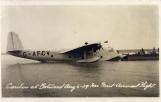1
Taking over from Imperial Airways in 1939, BOAC quickly came the predominant airline in Western Europe. Their flying boat operation capitalized mainly on the European market, but like Pam Am they were looking for a way to establish a more efficient route to North America.In many ways, BOAC was a pioneer in opening up the North Atlantic Route. They experimented with numerous methods of allowing a flying boat to lift off and consume as little fuel as possible. Assisted takeoffs were also an option explored. A smaller plane was mounted on the back of a larger plane, with the larger plane being used as a "sling shot" to propel the other plane into the air.
BOAC began their passenger service across the Atlantic around the same time as the Pam Am operation, quickly gaining a foothold on the lucrative transatlantic market. During the height of its operation, BOAC easily matched Pan Am with their Sikorsky S.42 Empire Class Flying boats and Boeing B314 Clippers.
In 1943, by agreement between Canada and Newfoundland, Canada handed over some of the Anti Aircraft Battery buildings to provide accommodations and a restaurant for passengers and crews on the transatlantic service. The buildings were operated by British Overseas Airways Corporation (BOAC) and became known as Caledonia Camp, named for the Imperial Airways flying boat that made the first experimental crossing of the Atlantic in 1937. BOAC accepted the buildings as they were and the Department of National Defence charged no rent. The camp was jointly financed by the United Kingdom and Newfoundland.
Daily, the giant airliners of the BOAC, Pan American and Export Airlines circled the calm waters of Botwood harbour. Their passengers disembarked at the pier sacred to the RCAF during the years when its dawn patrol was writing history and helping win the Battle of the Atlantic. Airliner passengers were driven to the rest in luxury at Caledonia Camp during the one and a half hour stop while their plane was being refueled. At Caledonia Camp, the Caribou Club complete with bar, and up-to-date restaurant and other facilities, helped passengers pass the time in comfort and pleasure (Blackmore, 1946).
Winston Churchill rested in the little "blue and white cabin on the hill" which was reserved for mighty personages. The great leaders of the land, sea, and air offensive, as well as the great financiers and jugglers of power passed through here at some time or other during the war years.






